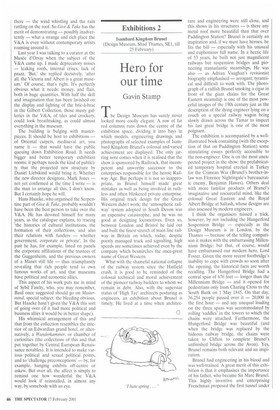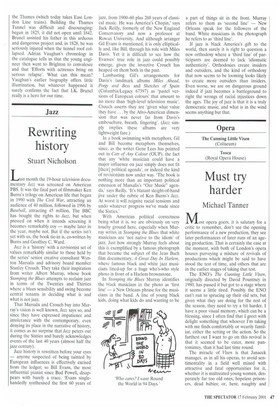Isambard Kingdom Brunel (Design Museum, Shad Thames, SE1, till 25 February)
Hero for our time
Gavin Stamp
The Design Museum has surely never looked more coolly elegant. A row of fat red columns runs down the centre of the exhibition space, dividing it into bays in which models, engineering drawings and photographs of selected examples of Isambard Kingdom Brunel's colossal and varied achievement are displayed. The only jarring note comes when it is realised that the show is sponsored by Railtrack, that incompetent and unworthy successor to the enterprises responsible for the heroic Railway Age. But perhaps it is not so inappropriate, as Brunel himself made great mistakes as well as being involved in ruthless and often blinkered private enterprise. His original track design for the Great Western didn't work; the 'atmospheric railway' system adopted in South Devon was an expensive catastrophe; and he was no good at designing locomotives. Even so, between London and Bristol he laid out and built the finest stretch of main line railway in Britain on which, today, despite poorly managed track and signalling, high speeds are sometimes achieved even by the company which besmirches the once-great name of Great Western.
What with the shameful national collapse of the railway system since the Hatfield crash, it is good to be reminded of the colossal technical and moral achievement of the pioneer railway builders to whom we remain in debt. Also, with the superstar status of 'High Tec' architects posturing as engineers, an exhibition about Brunel is timely. He lived at a time when architec ture and engineering were still close, and this shows in his structures — is there any metal roof more beautiful than that over Paddington Station? Brunel is certainly an inspiration and, if we must have heroes, he fits the bill — especially with his unusual and euphonious full name. In a hectic life of 53 years, he built not just magnificent railways but suspension bridges and pioneering transatlantic steamships. He was also — as Adrian Vaughan's revisionist biography emphasised — arrogant, tyrannical and difficult to work with. The photograph of a raffish Brunel smoking a cigar in front of the giant chains for the Great Eastern steamship is one of the most powerful images of the 19th century just as the description of the dying engineer lying on a couch on a special railway wagon being slowly drawn across the Tamar to inspect his last great bridge is one of the most poignant.
The exhibition is accompanied by a wellillustrated book containing (with the exception of that on Paddington Station) some stimulating essays perfectly accessible to the non-engineer. One is on the most unexpected project in the show: the prefabricated temporary hospital erected in Turkey for the Crimean War (Brunel's brother-inlaw was Florence Nightingale's bureaucratic enemy, Benjamin Hawes). Others deal with more familiar products of Brunel's imaginative and resourceful mind, like the colossal Great Eastern and the Royal Albert Bridge at Saltash, whose designs are also assessed by modern engineers.
I think the organisers missed a trick, however, by not including the Hungerford Suspension Bridge — especially as the Design Museum is in London, by the Thames — because of the telling comparison it makes with the embarrassing Millennium Bridge; but that, of course, would have embarrassed our modern hero, Lord Foster. Given the more recent footbridge's inability to cope with crowds so soon after the opening, the historical facts are worth recalling. The Hungerford Bridge had a central span of 676 feet — longer than the Millennium Bridge — and it opened for pedestrians only from Charing Cross to the South Bank on 1 May 1845. On that day, 36,254 people passed over it — 20,000 in the first hour — and any unequal loading on the three spans was accommodated by rolling 'saddles' in the towers to which the chains were attached. Furthermore, the Hungerford Bridge was beautiful (and when the bridge was replaced by the hideous railway bridge, the chains were taken to Clifton to complete Brunel's unfinished bridge across the Avon). Yes, Brunel remains both relevant and an inspiration.
Brunel had engineering in his blood and was well-trained. A great merit of this exhibition is that it emphasises the importance of his father, who became Sir Marc Brunel. This highly inventive and enterprising Frenchman proposed the first tunnel under
the Thames (which today takes East London Line trains). Building the Thames Tunnel was difficult and discouraging: begun in 1825, it did not open until 1842. Brunel assisted his father in this arduous and dangerous project and, in 1828, he was seriously injured when the tunnel roof collapsed. Adrian Vaughan's chronology in the catalogue tells us that the young engineer then went to Brighton to convalesce and that 'Efforts with actresses bring on serious relapse'. What can this mean? Vaughan's earlier biography offers little illumination, but whatever happened it surely confirms the fact that I.K. Brunel really is a hero for our time.



































































 Previous page
Previous page